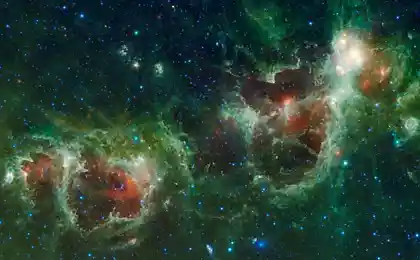811
Humanity - one of the first civilizations?
Fermi Paradox: Where are they?
Once on the approval of the plurality of inhabited worlds in our galaxy outstanding Italian physicist Enrico Fermi answered with a question: "And where are they?". This simple in its essence the question is still baffling scientists and enthusiasts just interested in the problem of the search for extraterrestrial civilizations. This problem is so named in honor of the scientist, so easy to formulate it, - "Fermi paradox».
It has since been broken a lot of copies to somehow explain or resolve the paradox. They offered a variety of explanations for why we still have not been able to find no sign of the existence of any thinking civilization other than Earth.
Polish science fiction writer Stanislaw Lem in his novel "fiasco" for an explanation of this fact introduces the concept of a "window of contact." According to his concept, thinking civilization is only a very short time in a state where it can and wants to establish contact with other civilizations. Up to this point she had not technically able to do so (for example, not yet invented the radio), and then, after the contact window, civilization or does not want to do that, because it starts to deal with the fact that it is not clear to others or herself ruins of one reason or another. But since we have no reason to believe that civilization in the galaxy there are both developed with the same pace, it is clear that the window of contact from civilization does not coincide in time and space. And because we can not see or hear them. [Next]
The concept is certainly interesting and worthy of attention. But in this article we will try to look at the problem from a slightly different position - namely, in the light of recent discoveries and refinements earth astrophysicists. Of course, poverty raw data, accurate calculations produce impossible. Therefore, all this will be only in the form of arguments and conclusions.
The anthropic principle
Recently, after nine years of research relic background radiation of the universe, astrophysicists have concluded that since the Big Bang took place 13 to 75 billion years. I note that before the age of our universe is estimated at 25-30 billion years. It would seem, what does this have to search for extraterrestrial intelligence? It turns out that the most immediate. But now let us return to our civilization.
The so-called anthropic principle states that human civilization exist precisely because in our Universe are just such laws. In other words, the current universe favors the emergence and existence of man.
This principle can be interpreted in two ways:
1) Since the universe favors the existence of man, the unique humanity and other civilizations in the Universe.
2) Since the universe favors the existence of man, and in other places of the universe, and there may be the same or similar to the civilization of mankind, as the universal laws of the universe.
The first statement will not be considered for the reason that it once and for all eliminates any problem search for extraterrestrial intelligence. Since humanity is unique, it is, therefore, and look for nothing. Here and so everything is simple and clear. As they say, to "no" and no court.
Let us second statement.
First Data. Agree in advance that they are not indisputable, but, unfortunately, others we do not have.
Age mankind is estimated by scientists at 70-80 million years old. Of these, as a civilization - a maximum of 10-12 thousand years. And only 100 years, mankind has acquired the ability to establish radio contact with extraterrestrial objects. Speaking terminology Stanislaw Lem, humanity has just waltzed in the "window contact».
We live on a solid planet orbiting the star of the ordinary - a yellow dwarf. The uniqueness of our planet is the temperature at the surface allows the water in the liquid state. If it were not so, life on Earth would be unable to appear.
Age of our Earth scientists estimated to be about 4-4, 5 billion years. It is virtually the same as the age of our sun. Sun refers to a second generation of stars. That is, it is formed from a material that remained after the supernova explosions of stars of the first generation, ie those generated directly from the primary plasma remaining after the Big Bang.
Are there pratsivilizatsii?
In many works of fiction, you can read about some of the primary civilizations arose billions of years before the appearance of mankind, and reached the incredible scientific and technological power. Let's see, whether such.
Thus, the Big Bang. For the first billion years of the universe in this raging could hardly have come at least some lives (any plasma, gas and other "variety of life" will not be considered, that is the lot of science fiction). The entire cosmos is stuffed severe radiation, matter exists only in the form of ionized hydrogen and helium atoms. No other materials. Any more complex compounds and molecules, even if they are formed, then immediately destroyed by radiation. And gradually the temperature falls, and begins the formation of the first stars and galaxies. There are very hot, giant stars, consisting entirely of hydrogen. Planets are formed and if, then only hydrogen-helium gas giant. For other materials for them do not already exist. All of this suggests that planets such as Earth, Venus or Mars, the stars of the first generation was not yet.
Life is the hot supergiants is very short. Such stars are very quickly expend its hydrogen, and then they expect a gravitational collapse, if the star is very large and heavy, or explosion as a supernova. When a supernova explosion almost all the matter of the star is ejected into the surrounding space, and on the site of the former star is a very dense, consisting essentially of one neutron, small core, called a neutron star. But we are interested in now is not the neutron stars, namely a substance that was dropped during the explosion.
During the short period of its existence, the first generation of stars in its bosom processed a huge amount of atoms of hydrogen and helium into heavier elements. Indeed, for these stars of the Universe appeared enormous factories for the production of elements such as oxygen, nitrogen, carbon, silicon, iron and heavier, up to uranium. And all this stuff the first generation of stars was ejected into space. Now, in the universe there is a building material for the formation of a second generation of stars, including our sun. And more importantly, there is the material for the formation of Earth-like planets, that is, with a solid surface, the atmosphere of the heavy gases such as nitrogen, oxygen, methane, carbon dioxide. That's it - the key ingredients needed for life. We can say with certainty that our bodies are 100% composed of a substance which was formed in the depths of primary stars of the early universe.
And this gives us reason to believe that any pratsivilizatsy with milliardoletnimi ages of the universe does not exist. Not because of what they would be.
The first civilization of the Cosmos
Thus, life could arise only on the Earth-like planets orbiting the star of the second generation.
The second generation of stars in the vast majority are between the ages of 5-7 billion years. About the same age and have planets orbiting these stars, since they formed at the same time from the remnants of supernovae.
We have no reason to believe that the Sun, Earth and mankind living on this earth, is a something uncommon. Therefore, we assume that the human civilization - the most typical.
With this assumption, we come to the following conclusion:
Mankind appeared 70 million years ago. Almost yesterday, by the standards of the universe. That is, since the birth of the Sun and the Earth passed 4, 5 billion years. If we assume that this is a typical phenomenon for the entire universe, we come to the sad conclusion that other civilizations of the cosmos are roughly the same level of development as we are. If the deviation is, they may not be significant. Account will go only plus / minus several thousand years. Some civilizations can keep up with, some - are ahead of us in development, but not much. We - one of the first civilizations that emerged in the universe. That's what we can proudly assert.
Since this is so, we are now able to answer the question of why we can not detect extraterrestrial intelligence. We can not find them because they are at the same level of development, and humanity. That is, their technological level is still such that their activity has not come out into space, to the extent that it could be detected. So, no Dyson spheres and other cosmic wonders in our galaxy there, and today can not be. The first civilizations of the cosmos, including us, too, for such is unable to.
In general, we ever find them? Or do they have? I think it will happen. But not tomorrow, not in a hundred years. This will happen when humanity will be able to enter the interstellar highway. Accordingly, civilizations, our peers, too. Forecasts of the most optimistic-minded scientists are such that his first interstellar ship of humanity will be able to build through the years 250-300, when they developed reliable technology of controlled thermonuclear fusion. Kerosene will not fly to the stars.
In the meantime, we have to rely only on radio. It is possible that someone in the depths of the galaxy accidentally send your antenna toward the sun, and will give a signal. But the likelihood of such an event is extremely small. Expect the same that any civilization will be able to conduct continuous omnidirectional transmission, it is not necessary on the basis of the aforementioned considerations. Installed power and technological development occurred simultaneously (at the same time on a cosmic scale of time) with us this civilization can not even afford.
© Dmitry Alexeyev, for the site SETI & CETI.

Source:
Once on the approval of the plurality of inhabited worlds in our galaxy outstanding Italian physicist Enrico Fermi answered with a question: "And where are they?". This simple in its essence the question is still baffling scientists and enthusiasts just interested in the problem of the search for extraterrestrial civilizations. This problem is so named in honor of the scientist, so easy to formulate it, - "Fermi paradox».
It has since been broken a lot of copies to somehow explain or resolve the paradox. They offered a variety of explanations for why we still have not been able to find no sign of the existence of any thinking civilization other than Earth.
Polish science fiction writer Stanislaw Lem in his novel "fiasco" for an explanation of this fact introduces the concept of a "window of contact." According to his concept, thinking civilization is only a very short time in a state where it can and wants to establish contact with other civilizations. Up to this point she had not technically able to do so (for example, not yet invented the radio), and then, after the contact window, civilization or does not want to do that, because it starts to deal with the fact that it is not clear to others or herself ruins of one reason or another. But since we have no reason to believe that civilization in the galaxy there are both developed with the same pace, it is clear that the window of contact from civilization does not coincide in time and space. And because we can not see or hear them. [Next]
The concept is certainly interesting and worthy of attention. But in this article we will try to look at the problem from a slightly different position - namely, in the light of recent discoveries and refinements earth astrophysicists. Of course, poverty raw data, accurate calculations produce impossible. Therefore, all this will be only in the form of arguments and conclusions.
The anthropic principle
Recently, after nine years of research relic background radiation of the universe, astrophysicists have concluded that since the Big Bang took place 13 to 75 billion years. I note that before the age of our universe is estimated at 25-30 billion years. It would seem, what does this have to search for extraterrestrial intelligence? It turns out that the most immediate. But now let us return to our civilization.
The so-called anthropic principle states that human civilization exist precisely because in our Universe are just such laws. In other words, the current universe favors the emergence and existence of man.
This principle can be interpreted in two ways:
1) Since the universe favors the existence of man, the unique humanity and other civilizations in the Universe.
2) Since the universe favors the existence of man, and in other places of the universe, and there may be the same or similar to the civilization of mankind, as the universal laws of the universe.
The first statement will not be considered for the reason that it once and for all eliminates any problem search for extraterrestrial intelligence. Since humanity is unique, it is, therefore, and look for nothing. Here and so everything is simple and clear. As they say, to "no" and no court.
Let us second statement.
First Data. Agree in advance that they are not indisputable, but, unfortunately, others we do not have.
Age mankind is estimated by scientists at 70-80 million years old. Of these, as a civilization - a maximum of 10-12 thousand years. And only 100 years, mankind has acquired the ability to establish radio contact with extraterrestrial objects. Speaking terminology Stanislaw Lem, humanity has just waltzed in the "window contact».
We live on a solid planet orbiting the star of the ordinary - a yellow dwarf. The uniqueness of our planet is the temperature at the surface allows the water in the liquid state. If it were not so, life on Earth would be unable to appear.
Age of our Earth scientists estimated to be about 4-4, 5 billion years. It is virtually the same as the age of our sun. Sun refers to a second generation of stars. That is, it is formed from a material that remained after the supernova explosions of stars of the first generation, ie those generated directly from the primary plasma remaining after the Big Bang.
Are there pratsivilizatsii?
In many works of fiction, you can read about some of the primary civilizations arose billions of years before the appearance of mankind, and reached the incredible scientific and technological power. Let's see, whether such.
Thus, the Big Bang. For the first billion years of the universe in this raging could hardly have come at least some lives (any plasma, gas and other "variety of life" will not be considered, that is the lot of science fiction). The entire cosmos is stuffed severe radiation, matter exists only in the form of ionized hydrogen and helium atoms. No other materials. Any more complex compounds and molecules, even if they are formed, then immediately destroyed by radiation. And gradually the temperature falls, and begins the formation of the first stars and galaxies. There are very hot, giant stars, consisting entirely of hydrogen. Planets are formed and if, then only hydrogen-helium gas giant. For other materials for them do not already exist. All of this suggests that planets such as Earth, Venus or Mars, the stars of the first generation was not yet.
Life is the hot supergiants is very short. Such stars are very quickly expend its hydrogen, and then they expect a gravitational collapse, if the star is very large and heavy, or explosion as a supernova. When a supernova explosion almost all the matter of the star is ejected into the surrounding space, and on the site of the former star is a very dense, consisting essentially of one neutron, small core, called a neutron star. But we are interested in now is not the neutron stars, namely a substance that was dropped during the explosion.
During the short period of its existence, the first generation of stars in its bosom processed a huge amount of atoms of hydrogen and helium into heavier elements. Indeed, for these stars of the Universe appeared enormous factories for the production of elements such as oxygen, nitrogen, carbon, silicon, iron and heavier, up to uranium. And all this stuff the first generation of stars was ejected into space. Now, in the universe there is a building material for the formation of a second generation of stars, including our sun. And more importantly, there is the material for the formation of Earth-like planets, that is, with a solid surface, the atmosphere of the heavy gases such as nitrogen, oxygen, methane, carbon dioxide. That's it - the key ingredients needed for life. We can say with certainty that our bodies are 100% composed of a substance which was formed in the depths of primary stars of the early universe.
And this gives us reason to believe that any pratsivilizatsy with milliardoletnimi ages of the universe does not exist. Not because of what they would be.
The first civilization of the Cosmos
Thus, life could arise only on the Earth-like planets orbiting the star of the second generation.
The second generation of stars in the vast majority are between the ages of 5-7 billion years. About the same age and have planets orbiting these stars, since they formed at the same time from the remnants of supernovae.
We have no reason to believe that the Sun, Earth and mankind living on this earth, is a something uncommon. Therefore, we assume that the human civilization - the most typical.
With this assumption, we come to the following conclusion:
Mankind appeared 70 million years ago. Almost yesterday, by the standards of the universe. That is, since the birth of the Sun and the Earth passed 4, 5 billion years. If we assume that this is a typical phenomenon for the entire universe, we come to the sad conclusion that other civilizations of the cosmos are roughly the same level of development as we are. If the deviation is, they may not be significant. Account will go only plus / minus several thousand years. Some civilizations can keep up with, some - are ahead of us in development, but not much. We - one of the first civilizations that emerged in the universe. That's what we can proudly assert.
Since this is so, we are now able to answer the question of why we can not detect extraterrestrial intelligence. We can not find them because they are at the same level of development, and humanity. That is, their technological level is still such that their activity has not come out into space, to the extent that it could be detected. So, no Dyson spheres and other cosmic wonders in our galaxy there, and today can not be. The first civilizations of the cosmos, including us, too, for such is unable to.
In general, we ever find them? Or do they have? I think it will happen. But not tomorrow, not in a hundred years. This will happen when humanity will be able to enter the interstellar highway. Accordingly, civilizations, our peers, too. Forecasts of the most optimistic-minded scientists are such that his first interstellar ship of humanity will be able to build through the years 250-300, when they developed reliable technology of controlled thermonuclear fusion. Kerosene will not fly to the stars.
In the meantime, we have to rely only on radio. It is possible that someone in the depths of the galaxy accidentally send your antenna toward the sun, and will give a signal. But the likelihood of such an event is extremely small. Expect the same that any civilization will be able to conduct continuous omnidirectional transmission, it is not necessary on the basis of the aforementioned considerations. Installed power and technological development occurred simultaneously (at the same time on a cosmic scale of time) with us this civilization can not even afford.
© Dmitry Alexeyev, for the site SETI & CETI.

Source:























